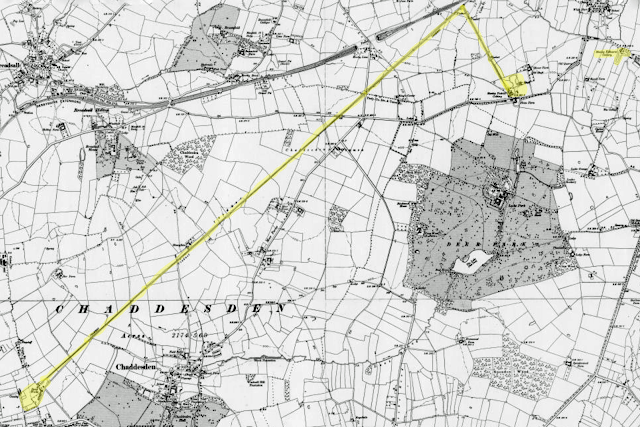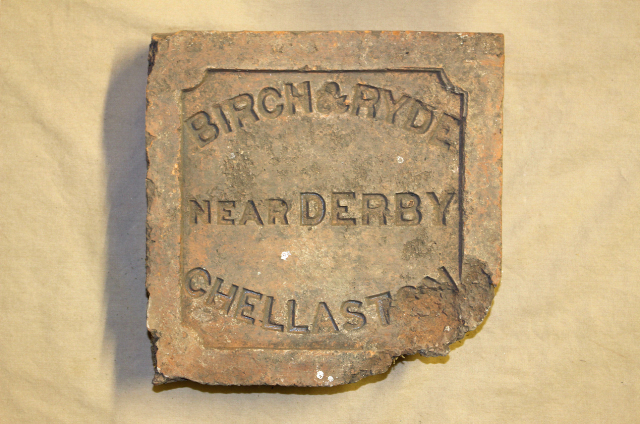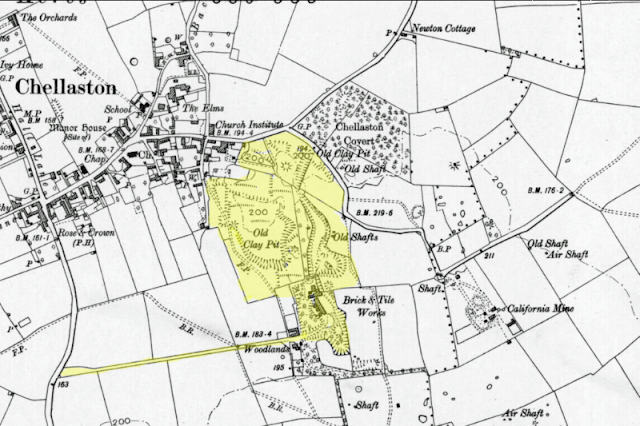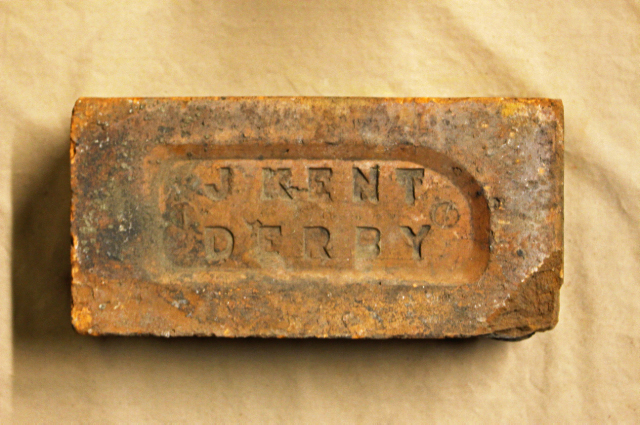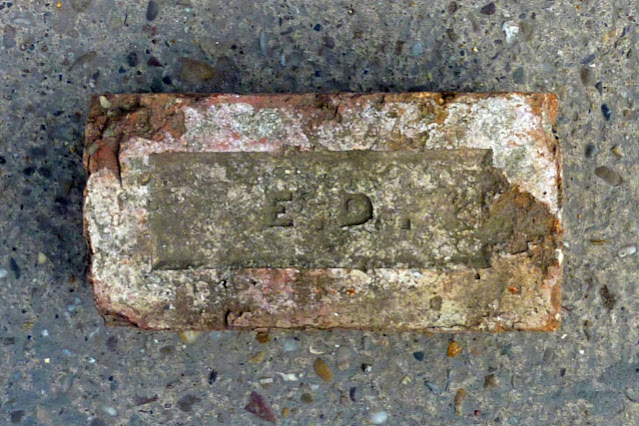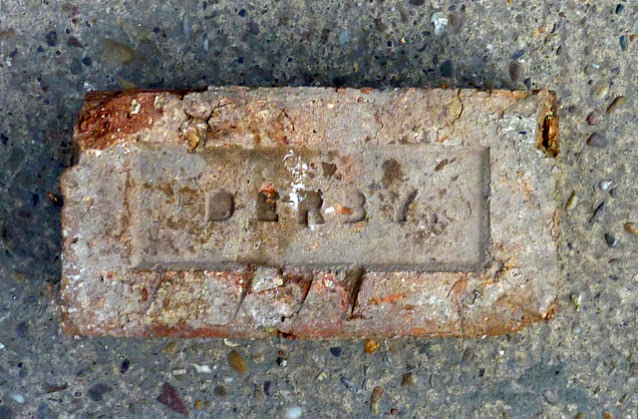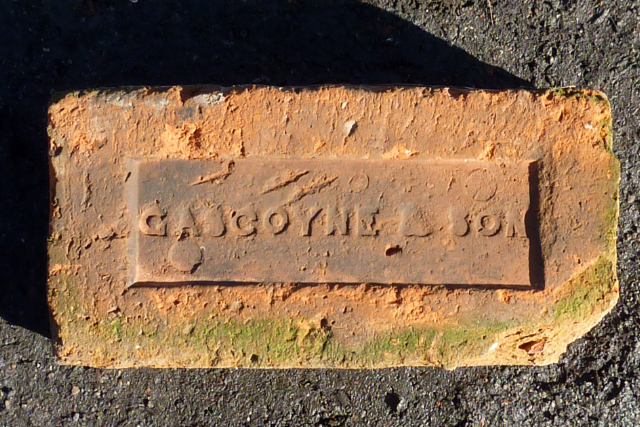In part 2 of Derby Brickworks, I cover the brickmakers who operated in the rest of Derby.
Normanton.
I start with a brickworks which was known as Melbourne Junction, Normanton Brickworks & Sinfin Lane. This works was next to the railway at Melbourne Junction & is recorded on maps as the Normanton Brickworks on Sinfin Lane, Normanton.
© Crown Copyright. Reproduced with permission of NLS/Ordnance Survey 1900.
Photo taken at the Silk Mill Museum, Derby.
As wrote in Derby Brickmakers - part 1 John Holmes had been in the partnership of Bennett, Holmes & Kay at Stockbrook Lane up to early 1878. John then went on to open up a new brickworks at Melbourne Junction, naming it the Junction Brickworks as recorded in the Derbyshire Advertiser newspaper dated 26th of July 1878 - shown below. This brickworks site which contained a very deep & extensive bed of superior brick clay situated next to the Birmingham to Derby Railway had been originally advertised "To Let" by Mr. John Shaw of College Place, Derby in a newspaper advert dated 21st of August 1872. So it appears that this site was not let until John Holmes came along in 1878. I do not have any trade directory entries for John Holmes at this works only the census listing in 1881 recording him as a brickmaker & as wrote in Derby Brickmakers - part 1, he may have taken up brickmaking with Thomas Bennett as early as 1872, because in the 1871 census he is recorded as grocer & flour dealer.
My next newspaper find in the Derbyshire Advertiser dated 5th of January 1883 advertises John Holmes of the Melbourne Junction Brickworks was selling 30,000 assorted drain pipes, a Schofield's brick making machine, a Schofield brick press & other brick making plant. Apply at the Works or J. Holmes, Victoria Villas, Uttoxeter New Road, Derby. Then another notice in the Derby Daily Telegraph dated 27th January 1883 reports Mr. Miles was auctioning the previously listed drain pipes & machinery at the Melbourne Junction Brickworks. So in conclusion John had decided to close the brickworks.
It then appears Thomas Bennett, the Bennett in Bennett, Holmes & Kay, after working at the Parcel Terrace Brickworks, then takes over this Melbourne Junction works on Sinfin Lane. Kelly's 1887 edition lists Thomas Bennett as brickmaking at Sinfin Lane, Derby. According to his descendant Thomas died in 1891 while still working as a brickmaker. As yet no bricks have turned up made by Thomas at this works.
Photo taken at the Silk Mill Museum, Derby.
The next owner of this Melbourne Junction brickworks, Sinfin Lane was John Walley junior & he is recorded at the Normanton Brickworks in Kelly's 1891 edition. This is the only entry for Walley as we next find William Eaton is listed in Kelly's 1895, 1899 & 1904 editions at Normanton. William Eaton is also recorded as living in Normanton. In 1906 William Eaton joined forces with four other Derby brickmakers in forming the Derby Brick Company & I write more about Eaton & his Normanton works in Derby Brickworks - part 1.
Further research has revealed William Eaton from 1895 was a co-partner with Samuel Hall at the Bull Bridge Brick Co. in Sawmills, Ambergate, Derbys. & from the 13th of October 1899 this partnership was dissolved by mutual consent & the Sawmill's works was then to be solely operated by William Eaton under his own name which he continued to run up to 1916.
© Crown Copyright. Reproduced with permission of NLS/Ordnance Survey 1880.
Reading/Normanton brick photographed at the Silk Mill Museum, Derby.
The London Gazette dated 2nd October 1877 records James Reading, builder & brickmaker of Burton Road, Derby; brickworks, Normanton, had declared himself bankrupt & any debts not yet proven were to be declared before the 12th of October 1877 to William Holbrook, Auctioneer & Accountant of Full Street, Derby. Dated 29th of September 1877. The 1880 OS map above shows two brick yards to the north-west of the village, one of which is marked as disused (coloured green) & it is this works which I am favouring was owned by James Reading. It is unknown who owned the purple coloured works. The 1899 OS map shows no trace of either of these two brickworks.
Spondon.
© Crown Copyright. Reproduced with permission of NLS/Ordnance Survey 1881.
Although I do not have proof of the ownership of these yards, I think that the yellow works was owned in 1881 by Richard Bennett then by Richard Bennett & Co. after his death in 1885, closing around 1897. The blue disused works may have been owned by Richard's father Thomas Bennett. This leaves the red works & I have two entries in Kelly's 1876 & 1881 editions for the Antill Brothers brickmaking at Spondon & this may have been their yard. As yet no bricks have been found with Antill Brothers stamped in them.
Photo taken at the Silk Mill Museum, Derby.
Chaddesden Hill.
© Crown Copyright. Reproduced with permission of NLS/Ordnance Survey 1900.
Charles Dyche is listed in Kelly's 1855 & White's 1857 editions at Chaddesden Hill, Derby. Although I do not know the exact location of Charles Dyche's brickworks at Chaddesden Hill in 1855, I have used the 1900 map above to show a later brickworks owned by the Derby Kilburn Colliery Company which was also situated on Chaddesden Hill. So Charles' brickworks may have occupied the same or a close by site. Where it says Cowsley on the map above the 1880 map reveals a pond/area of water which may have been Charles' clay pit ?
This Chaddesden brick, photographed at the Silk Mill Museum, Derby has Dyche stamped on the other side, but unfortunately I did turn the brick over to photograph it. Then a fellow collector photographed the same brick & this has revealed that it has got the same stamp mark as the Dyche brick above which I have got in my collection, but mine has not got Chaddesden on the reverse.
There is the possibility that because of the texture of the clay this Derby brick was also made by Charles Dyche. I have also found a J. Dyche is listed in Kelly's 1855 edition at 51 Sitwell Street, Derby & Sitwell Street is in nearby Spondon. So this J. Dyche may have lived at this address & then worked with Charles ?
I now move on to the Derby Kilburn Colliery Company who's brickworks was also on Chaddesden Hill.
The Derby Kilburn Colliery Company was formed on the 2nd of April 1891 with a capital of £30,000 in £100 shares & in doing so took over a colliery at Stanley called the Stanley Kilburn Colliery previously owned by the Small Brothers who went bankrupt in 1885. The first directors of this new company were T.P. Hickman & C. Moore. It may have been from this colliery's name that Derby Kilburn Colliery Company took part of it's name from. The company then expanded by opening the Footrill drift mine which was to the south-west of Manor Farm in Stanley. They used Stanley Kilburn pit to vent air into & pump water out of the drift mine. D.K.C.C. then built their own tramway from the drift mine to Chaddesden Hill from where their coal was conveyed to Derby. It may have been after this tramway was up & running that DKCC then opened their brickworks at Chaddesden Hill & the works is shown on the 1900 OS map above at the terminus of the tramway. Bricks were made using clay shale from the mine in beehive kilns & some of these bricks where used to build four semi-detached houses at Klondyke on the edge of Stanley village. By 1918 D.K.C.C. had closed their brickworks & Stanley pit due to financial difficulties & their works was sold over three days on the 30th April, 1st & 2nd of May 1919. I have found that the Footrill drift mine had already been taken over by the Mapperley Colliery Company in December 1908.
© Crown Copyright. Reproduced with permission of NLS/Ordnance Survey 1900.
The 1900 map above shows the distance the tramway travelled from the Footrill's drift mine near Stanley village to Chaddesden Hill. It must have been a feat of engineering to build this tramway. Also coloured yellow is Stanley Kilburn Colliery. If you wish to study this map in more detail I have pasted the link below.
https://maps.nls.uk/view/101601561
Also if you wish to read more details about this amazing tramway, please follow the link below.
https://www.chaddesdenhistorygroup.co.uk/colliery-tramway-opening
© Crown Copyright. Reproduced with permission of NLS/Ordnance Survey, surveyed 1879/81.
My first reference to a brick-yard at Chellaston comes in the form of a "For Sale" advert which appeared in the Derbyshire Advertiser dated 27th of March 1863. "To be Sold or Let with immediate possession, excellent brick-yard standing on 6 acres of land, with first-rate bed of clay, dwelling house, kiln, sheds, stables, outbuildings & plant etc. Apply Mr. Pool, Auctioneer, Derby. Birch & Ryde are listed in Kelly's 1876 edition as brickmakers at Chellaston, so had this duo purchased this works from Mr. Pool in 1863 ?
In Wright's 1874 edition Birch & Ryde are listed as plaster pit owners & may have owned the California gypsum mine marked just to the right of the brickworks on the 1879 map above. It is in Kelly's 1876 edition that we find that Birch & Ryde are listed as brick & tile manufacturers at Chellaston. As you can see on the map above there is no clay pit next to the works, so as well as bringing coal to the works via their tramway, B & R must have also brought clay to the works via road & then their tramway. As to where the clay came from whether it was from their gypsum mine or a 2nd option is the unmarked (at this date) clay pit with tramway which I have coloured blue, is unknown. If they did own the blue coloured area, it appears that they did not own the land between the clay pit & the brickworks, so therefore they had transport the clay by road & then by their tramway to the works. A later map does show that the next owners of the works did have direct access to this clay pit.
In Wright's 1874 edition Birch & Ryde are listed as plaster pit owners & may have owned the California gypsum mine marked just to the right of the brickworks on the 1879 map above. It is in Kelly's 1876 edition that we find that Birch & Ryde are listed as brick & tile manufacturers at Chellaston. As you can see on the map above there is no clay pit next to the works, so as well as bringing coal to the works via their tramway, B & R must have also brought clay to the works via road & then their tramway. As to where the clay came from whether it was from their gypsum mine or a 2nd option is the unmarked (at this date) clay pit with tramway which I have coloured blue, is unknown. If they did own the blue coloured area, it appears that they did not own the land between the clay pit & the brickworks, so therefore they had transport the clay by road & then by their tramway to the works. A later map does show that the next owners of the works did have direct access to this clay pit.
B & R's brick & tile where both photographed at the Silk Mill Museum, Derby.
Photo by Simon Booth.
© Crown Copyright. Reproduced with permission of NLS/Ordnance Survey 1899.
As you can now see on the 1899 map above the tramway has gone & the works has direct access to the clay pits, some of which are marked as old clay pits by 1899.
So the next brickmaker to be recorded at Chellaston is T.P. Stableford in 1881 & he must have been responsible for extending the clay pits at the works.
Thomas Porter Stableford b.1821 is listed in Kelly's 1881 edition to it's 1904 edition as brick making in Chellaston. Then son John Thomas Stableford b.1862 is listed at this works in Kelly's 1908 to 1916 editions. A web article has revealed that John Thomas Stableford after the war modernised the works building a Hoffman kiln & replacing the steam engine with a gas fired one. In doing all these changes John got into financial trouble & to ease his situation he accepted a loan from F.W. Gilbert, however John soon got deeper into trouble & the the loan was foreclosed. F.W. Gilbert then took over the brickworks & John was made works manager, hence there being no more trade directory listings for John after 1916. In 1922 John Stableford was made redundant & the brickworks was closed by Gilbert. If you look at the 1899 map above you will see a house marked Woodlands next to the brickworks & this is where Thomas Stableford & John Stableford lived. These clay pits where also known as Woodlands Brickpits. As of yet, no bricks stamped John Stableford, Chellaston have turned up, unless he carried on stamping his bricks with his father's name on.
Both Stableford bricks where photographed at the Silk Mill Museum, Derby.
Photographed at the Silk Mill Museum, Derby by Frank Lawson.
© Crown Copyright. Reproduced with permission of NLS/Ordnance Survey, surveyed 1937/8.
From the same article as some of the Stableford info has come from, I found that in 1923 F.W. Gilbert joined forces with J.E. Williamson forming Chellaston Minerals & the Woodlands Brickworks was re-opened. Chellaston Minerals is first listed in Kelly's 1928 edition with J.E. Williamson as Managing Director.
Bricks were in great demand during both World Wars from this works especially the 2nd, because the Company (Chellaston Minerals) had to keep a sufficient stock of bricks to rebuild Rolls Royce in case of major damage by enemy bombs.
While digging for clay, gypsum was also dug & was sold to produced plaster by the company. The company continues to be listed in the brick & tile makers section of Kelly's Directory up to it's 1941 edition, the last available directory.
In 1948 the Woodland Brickworks was purchased by Mr. Sissons of Langley Mill who then change the company name to the Chellaston Brick Co. A gypsum mine article states that the gypsum on this site had run out by 1965. In 1976 a company called Granwood Flooring of Somercotes took over the brickworks, but after only two years the brickworks closed for good in 1978. Bricks made by these last two companies have still to turn up.
If you wish to view a 1937 photo of the Woodland Works on Picture the Past, I have pasted the link below.
http://www.picturethepast.org.uk/frontend.php?keywords=Ref_No_increment;EQUALS;DMAG000714&pos=2&action=zoom
Shelton Lock Brickworks near Chellaston.
© Crown Copyright. Reproduced with permission of NLS/Ordnance Survey, surveyed 1879.
Situated next to the Derby Canal I have coloured this Shelton Lock brickyard yellow on the 1879 map above. Thomas Cooper is recorded as brickmaker in White's 1857 edition at Shelton Lock, Chellaston with George Shelton listed as manager. However the Derbyshire Advertiser date 5th of September 1856 records Thomas Cooper as a Bankrupt & the Assignee had been charged to sell the Brick Yard & it's contents which included 150,000 common & pressed bricks on the 17th of September 1856. So I can only assume the trade directory had not been informed of Cooper's bankruptcy before it went to print. Cooper may have only operated this yard for a short time with him not being listed in Kelly's 1855 edition.
T. Cooper/Shelton brick photographed at the Silk Mill Museum, Derby.
A search in old newspapers has revealed Tomlinson & Harper next owned this Shelton Lock brickworks in the early 1860's & after their partnership was dissolved in 1863 it the took until May 1867 for the stock & equipment at this works to be sold at Auction as per a Notice in the Derbyshire Advertiser.
Thomas Clews, a farmer is next recorded as leasing this brick yard for a term of 10 years from the 25th of March 1876 at the minimum aggregate rents of £76 5s. 6d. According to this notice Thomas Clews also occupied the house which came with the brickyard. However as you will see the brick below is stamped A. Clews & Co. Thomas had a son called Arthur L. Clews & he is recorded as a brewers clerk, aged 17 in the 1871 census & it appears Thomas had leased the brickyard for Arthur to run. However A. Clews & Co. did not last long because in June 1880 the lease on the brickyard was once again being offered as a going concern & I found Arthur had moved to Wales as a Travelling Salesman in the brewery trade. There is another twist to tell you that in November 1880 Thomas Clews & Sons were advertising in the Derby Telegraph first class bricks for sale at reduced prices, so it appears Thomas had another son & they were running the brickyard together.
A. Clewes/Chellaston brick was photographed at the Silk Mill Museum, Derby by Frank Lawson.
As just wrote in June 1880 the Shelton Lock brickworks was advertised in the Derbyshire Advertiser to be Let as a going concern & it appears the lease was not taken up because in May 1885 the works was advertised again in the same newspaper, but this time to be Sold as a going concern, so I am thinking it was in May 1885 when the Shelton Brick Co. purchased the works. There are no Trade Directory listings for the Shelton Brick Co. so I do not know how long this company ran the works for. The Shelton Lock brickworks is no longer shown on the 1899 OS map.
Weston Underwood.
© Crown Copyright. Reproduced with permission of NLS/Ordnance Survey, surveyed 1880.
James Miller is listed in Kelly's 1864 to 1887 editions at Weston Underwood, Derby.
More can be read at the link below about James, his family & his brickworks in this blog written by one of his descendants Brett Payne who lives in New Zealand. A very interesting blog which requires more time to read his many posts about Derbyshire towns & it's inhabitants. The posts include many old photographs which is his passion.
http://photo-sleuth.blogspot.co.uk/2008/11/james-miller-1815-1893-drainage-man.html
Duffield.
© Crown Copyright. Reproduced with permission of NLS/Ordnance Survey, surveyed 1879/80.
I have been unable to find a brickmaker in trade directories with the initials of I.J. at Duffield, but I have found Samuel Jennens & Son recorded as brickmakers in Kelly's 1876 edition at Duffield, Belper. So I expect I.J. is more than likely the son.
Photos by MF, courtesy of the Frank Lawson collection.
I wish to thank the following people for their help & use of their maps & photos.
Silk Mill Museum, Derby - for giving me access to their brick collection & permission to use my images in this post.
http://www.derbymuseums.org
National Library of Scotland & Ordnance Survey - use of their maps.
Silk Mill Museum, Derby - for giving me access to their brick collection & permission to use my images in this post.
http://www.derbymuseums.org
National Library of Scotland & Ordnance Survey - use of their maps.
Frank Lawson - photos.


















